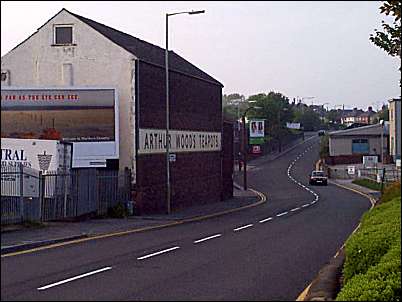|
Brownhills:
An elegant house, called Brownhills villa, has been
erected within the last seven years, on the west side of Brownhills,
by Messrs. Howard and Richard Howard Haywood ; who have, for several
years, carried on a large and lucrative business in the immediate
vicinity, as Brick and Tile Manufacturers.
The stile of this house exhibits much taste, and its situation,
opposite Bradwell wood, and the amphitheatre of hills extending
thence to Hare-castle, would be unexceptionable, but for the
Tileries, which emit their dusky volumes in the intervening space.
Messrs. Haywood have very lately introduced, at their works,
architectural ornaments of terra cotta, especially adapted
for edifices of the Elizabethan stile, the durable nature, elegant
forms, and cheapness of which can hardly fail to bring them speedily
into general favour.
There are two Potworks now carried on at Brownhills ; that
of Messrs. Marsh and Haywood, and that of Mr. George Hood ; the
latter situate at Highgate, and adjoining the town of Tunstall. All
the dwelling-houses and population, southward, of and
including Highgate inn, which are now numerous, belong to the
township of Burslem, and are included in the statistics of that
parish, and this portion of Burslem comprises about 480 inhabitants.
Ward - The Borough of Stoke-upon-Trent, 1843

View along Davenport Street
from Trubshaw Cross
photo: 2000
Davenport Street runs from Trubshaw
Cross roundabout [Brownhills Gate] at the bottom of
Newcastle Street and then joins onto Brownhills Road on the way
to
Tunstall. To the left of Davenport Street is Westport Lake and
the Trent and Mersey canal
"Mr. William
Littler, of Brownhills, near Burslem, whose father had carried
on business there as a Potter, and left to his son a small landed
estate, embarked in some expensive attempts to produce and article
resembling oriental china; he commenced business about the year
1745, when he attained his majority, and a few years afterwards
removed the seat of his manufacture to Longton Hall, where he
prosecuted his experiments with very good success, as regarded the
beauty and delicacy of his china, but with disastrous results to
himself ….. the specimens of Mr. Littler's china exhibit great
lightness and beauty…
Mr. Littler had
the merit of first making use of the fluid glaze which Mr. Enoch
Booth after wards improved upon."
John Wood (Ralph Jr.'s brother) - In
1787 John started his own pottery at Brownhills. Ralph Wood III
continued the firm after his father's murder.
Marsh & Heywood
Operated the Brownhill potteries from 1818 to 1837
Wood & Brettell
Operated works at Brownhills from 1818 to 1822
Edward Challinor was born on 18
July 1792, the son of William Challinor, attorney of Pickwood,
Leek, and Mary nee Bagnall. He was apprenticed to J. and R. Riley,
of Burslem, whose factory occupied the site of what later became
Hill Top Pottery.
From about 1828 Edward Challinor
leased the Overhouse pottery works to a succession of other potters.
Edward Challinor then joined in partnership with John Wood, making
pottery at Brownhills then at Woodlands, Tunstall.
G.F. Bowers (&Co)
Manufacturer of porcelain and pottery at Brownhills, Tunstall, c.
1842-68
In the 1846 directory
G.F.Bowers is listed as having Edward Challinor of Tunstall as a
partner.
In the 1851,52 directories the company is listed as Bowers,
Challinor & Wooliscroft.
In the 1861 census George
Frederick Bowers was age 52 - a pottery manufacturer and coal
master - employing 97 men, 19 boys and 20 girls.
Frederick T Bowers was the son of
George Frederick Bowers. F T Bowers ran the works until 1871.
The works were then purchased by James Eardley.
George Clews Co. Ltd. was first registered in 1906 as 'Jet
Manufacturers'. Operating at the Brownhills Pottery, Tunstall,
Stoke-on-Trent from 1906-1961
The 'jet' in question was a
red clay, dipped in a cobalt glaze, which on firing became the then
fashionable jet black. Their primary products were teapots. The company was
run by George's son Percy (Managing Director), and his partner Henry Preece (Sales
Director).
The Highgate Pottery, Brownhills....
George Hood was
in business in Tunstall as a pottery manufacturer from about
1822. He built Highgate Pottery, Brownhills, in1831 and took over
Walton's figure and toy factory in Navigation Road, Burslem, in
1835.
In January 1841 the
warehouse of the Walton factory, holding about ten tons of ware,
collapsed, and three of the 20 women workers below were seriously
injured. George Hood sold the Highgate Pottery in 1841. He started
up in business again in a works on Bourne's Bank, making figures and
dogs.
It is generally
accepted that George Hood is the 'George H.' referred to in
Charles Shaw's
When I was a Child. Shaw provides a vivid and fairly
sympathetic portrait of him, stout, cheery despite his financial
misfortunes, employing only a dozen people in his toy manufactory
instead of the scores he had previously employed, in a broken-
down works which produced mostly figures of Napoleon.
Thomas
Isaac & James Emberton
Earthenware manufacturers at the Highgate Pottery, Brownhills,
Tunstall from 1869-1882
They produced the usual kind of ware and also specialised in pottery
for the Indian and Far Eastern markets.
In 1871 the factory employed 47 men, 22 boys, 27 women and 27 girls.
William Emberton
purchase the Highgate Pottery from George Hood in 1846 and various
members of the family ran the works until 1888. William Emberton
(d.1867) Served on the Tunstall Board of Health (as Chairman 1865-6)
and as treasurer of Wesley Place Sunday School, Tunstall.
Alfred Meakin Ltd
was set up in 1875 and operated from the
Royal Albert,
Victoria and
Highgate Potteries in Tunstall. Alfred Meakin was the brother
of James
and George Meakin who ran a large pottery company in Hanley,
Stoke-on-Trent.

|